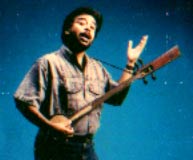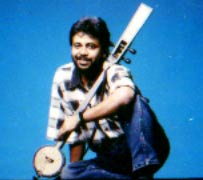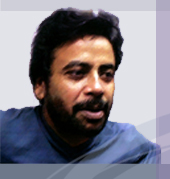The
Statesman Saturday July 29 1989

Collecting
folk music of the east
Swapan
Basu is addicted to folk music.He not only sings and
plays almost all the folk songs and instruments of eastern
India, especially of north-east, but also has a rare
collection of folk instruments, among which "ksing
dieng phong" - a xylophone-like cane instrument
known among the Garos as "dim srang" - is
a prized item. Swapan, in his early thirties, claims
to have collected at least 10,000 folk songs of eastern
and north-eastern India that, he says, can be preserved
if transformed into notations.
Swapan
has a six-episode TV serial to his redit, telecast on
the Second Channel of Calcutta Doordarshan recently.
If tried to document the folk music of West Bengal.
Its target was the urban audience, which is almost totally
unaware of the rich folk heritage of the State.
But, Swapan's versatility does not end here. He was
awarded a three-year national scholarship of the Department
of Culture. Government of India, in 1980-81 for training
of folk songs under the guidance of the late Hemango
Biswas Even before that, in 1979, he was selected by
All India Radio and Doordarshan. In the same year he
won the " Ujjal Protiva" award of AIR.
He
worked as a research fellow of Anthropological Survey
of India in ethno-musicology from 1984 to 1987. During
this period he did some field work on Meghalaya's folk
songs.Another research paper to his credit is: "
Ko Lapalang song" an ethno-musicological study
of Khasis of Meghalaya. He was awarded the research
fellowship for outstanding arts by the Ministry of Human
Resource Development, in 1987.
Swapa
was initially at tracted to theatre and joined Sansaptak
a theatre group, in the early seventies. After about
five years and numerous action and musical stints he
enrolled himself with Badal Sarkar's theatre group,
famous for its "third theatre" and street
plays. He composed the music for "Gandi",
- Brecht's Caucasian Chalk Circle - directed by Badal
Sarkar in the early eighties.
Early
in his performing life, he came into contact with Hemango
Biswas and Kalidas Gupta, two outstanding folk music
artistes who helped him in shaping his future. Later,
the late Ranen Roy Choudhury and Bihar Barua (now living
almost in recluse in Assam) guided Swapan in his endeavours.
Swapan
particularly excels in bhatiyali, bhoyaiya, chatka and
jhumur folk songs of Bengal and plays the ektara, dotara,
ananda lahiri, guitar and janjo with equal ease with
his songs. It has been a 13-year journey in folk song
collection for him, but he is worried about the future
because, as he says, the penetration of "urban
culture" - an imitation of Western countries has
done more damage than anything else to India's rich
folk heritage.

|
|
THE TELEGRAPH, WEDNESDAY 22 NOVEMBER 1989

Remarkable
flexibility
Swapan
Basu, a scholar and performer of folk music, has every
thing going for him. He has superb voice which is both
tuneful and full of life, is smart, witty and prompt
and has had a thorough grounding in folk songs. Arts
Acre must be congratulated for presenting him in a solo
vocal recital on November 17 at Rabindra Sadan.
Basu has been inspired by the late Hemanga Biswas and
the late Ranen Roy Chowdhury. Playing the dotara, he
began the evening with Moner bhab janarabe. He managed
to charm the audience with his clear concept of folk
songs. It is evident that the artiste has struggled
hard to preserve the songs from different parts of our
land and he easily proved that language is not a barrier
to any performing artiste.
In the first half, Basu selected some songs the lyrics
of which described the conversation between a young
girl and her parents. The parents are eager to marry
off their daughter. Tin jug chalia gelo was specially
appealing for its tal and tune. Bardai bardai dari kilaye
(Chittagong), a khasia folk and a Garo folk song showed
his clear experession combined with his sense of promotion.
After the interval, Basu sang several songs devoted
to Radha and Krishna.Prankrishna, Kinu muin abhagini
nari, (a song from Kamrup), Mathaihat dai sai bal and
aamar kalo pakhi gelo ure were attractive. The artiste
concentrated on all aspects of his gayaki and reflected
remarkable flexibility and dynamism. The Bihu brought
out a colourful and joyous mood.
|
|
THE STATESMAN,THURSDAY MARCH 6 1986
Swapan
Basu created a highly personal sound that was spontaneous
and communicative. The out going and life loving characteristics
of folk music found apt expression in all the songs
rendered by him. Specially to be mentioned are "E
mon ulta desh be guru (belonging to Bholagunge)","O
bhai fakir mulla re","Mathaye haath diyosol
balo" and "Jhanp diyona Kamnadite".
|








